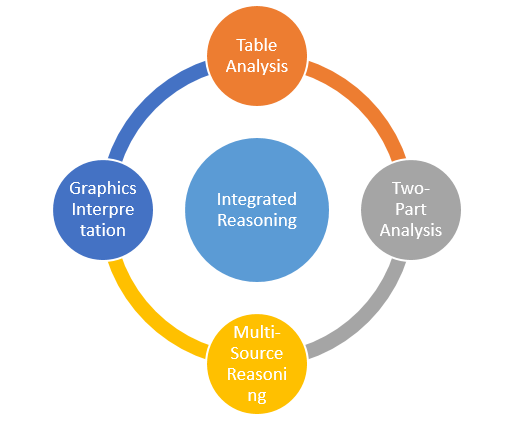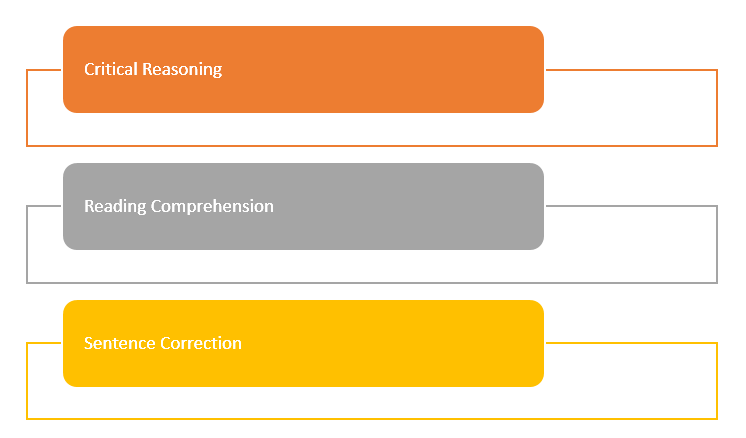GMAT Syllabus: Section-wise (AWA, IR, QR, VR) GMAT Exam Syllabus & Important Topics; www.gmac.com
MBA aspirants across the world take the GMAT entrance test to get into their dream B-school. The GMAT exam is a three and a half hours test with a maximum score of 800 points. The entire GMAT Syllabus is divided into four sections. In this article, we are going to discuss each and every section of the GMAT test format. GMAT Exam Syllabus covers 50 topics in these four sections. In this article, we will inform you about the GMAT Exam Syllabus 2022. Reading comprehension, sentence correction, and critical reasoning are covered under the Verbal section and data sufficiency and problem-solving are covered in the quant section. We have also discussed the topics that you should not miss while preparing for the GMAT Syllabus 2021.
Four sections of the GMAT Exam Syllabus
- Analytical Writing
- Integrated Reasoning
- Quantitative Aptitude Section
- Verbal Reasoning Section
GMAT Exam Pattern
The GMAT exam pattern is divided into four sections Writing, Reasoning, Verbal and Quantitative skills. Further, the GMAT is a Computer Adaptive Test of 3 hours 30 minutes and comprises both objective and subjective questions. There are a total of 91 questions.
| Section | Number of Questions | Score Range |
|---|---|---|
| Analytical Writing Assessment (30 minutes) | 1 Topic (Essay) | 0-6 |
| Integrated Reasoning (30 minutes) | 12 questions | 1-8 |
| Quantitative (62 minutes) | 31 questions | 6-51 |
| Verbal (65 minutes) | 36 questions | 6-51 |
| Total Exam Time (3 hours 7 minutes) |
Whether it is the GMAT Quant syllabus, GMAT Math syllabus, GMAT Verbal syllabus, or GMAT English syllabus, we have discussed all the sections of the GMAT syllabus 2022 below.
GMAT Analytical Writing Assessment Syllabus
The Analytical Writing section will have topics on which the candidate will have to write, or a passage may be given on which questions will be asked. On the basis of the passage, the candidate will have to answer. The syllabus for this section is vast and varied as the topic of the passage could be any topic of interest. The main idea is to focus on the structure of the answer and not the arguments presented. Remember, it is not a test of your opinion but your writing style, so it is safer to stick to a neutral opinion.
-
Argument essay
In this section, you have to analyse the reasoning and then present your argument. Remember, you will be judged on how well reasoned you find a given argument. Also, check whether the argument is logically sound or not and make sure not to make any baseless assumptions. Give importance to syntax and grammar to support or stand against the critique presented in the question.
-
Issue essay
In this section, you have to write an essay on the issue given to you. The candidate has to give an opinion in around 600 words. The opinion can be supportive of the given statement or candidates can give their own opinion. However, make sure to give your opinion in a properly structured manner as you will be judged on this basis.
GMAT Integrated Reasoning Syllabus
The Integrated Reasoning section is the newest addition to the GMAT Syllabus. This section tests the candidates’ ability to evaluate the data presented in graph or table format. This section has 12 questions of the following type:
-
Table Analysis:
This section measures candidates’ ability to sort and analyze a table comprising data, like a spreadsheet, to determine the important information or the one that meets certain conditions.
-
Two-Part Analysis:
Measures the candidates’ skills to solve complex problems. The problems can be verbal, quantitative, or a combination of both. The format is versatile and covers a wide range of content. The candidates’ ability to solve simultaneous equations, evaluate trade-offs, and discern relationships between two entities is measured.
-
Multi-Source Reasoning:
It measures candidates’ skills to examine data from multiple sources tables, graphics, text passages, or a combination of all the three and analyze each source of data carefully for answering multiple questions. The candidates will be asked to draw inferences and others may require you to determine whether data is important. In a few questions, candidates will have to recognize discrepancies among different sources of data.
-
Graphics Interpretation:
It measures candidates’ ability to interpret the information presented in a graph or graphical image (scatter plot, x/y graph, bar chart, pie chart, or statistical curve distribution) to find out relationships, and make inferences.
GMAT Quantitative Reasoning
The Quantitative Section comprises of two sections, namely Data Sufficiency and Problem Solving. In the Data Sufficiency section, there will be 18 questions and in the Problem Solving section, there will be 18 questions. The questions will be objective type and will have multiple choice answers. In this section the questions can be expected from the following math syllabus:
-
Problem Solving
50% of the total questions in the GMAT Quantitative section are from the Problem Solving. It measures the candidates’ skills to use logic and analytical reasoning for solving quantitative problems.
-
Data Sufficiency
It measures the candidates’ ability to examine a quantitative problem, identify which data is important, and determine at what point there are enough data to solve the problem.
GMAT Quant Section Topics
The topics are further divided into the following categories
| Arithmetic | Algebra | Geometry |
|---|---|---|
| Probability | Permutation and combination | Coordinate geometry |
| Ratio and proportion | Algebraic expressions and equations | Circles |
| Simple and Compounded Interest | Arithmetic and geometric progressions | Quadrilaterals |
| Speed, time, distance | Statistics | Triangle |
| Percentage | Exponents | Lines and angles |
| Average | Functions | |
| Fractions | ||
| Decimals | ||
| Number Properties | ||
| Multiples and Factors |
GMAT Verbal Reasoning Syllabus
This Verbal Skills section will have 36 multiple-choice questions. This section is divided into Critical Reasoning, Reading Comprehension, and Sentence Correction. This section tests the candidates’ ability to comprehend the written material, read and understand the logical relationship between the points mentioned in the passage and concepts.
-
Critical Reasoning
It measures the candidates’ skills to make arguments, evaluate arguments, and formulate or evaluate a plan of action.
-
Reading Comprehension
It measures the candidates’ skill to draw inferences, understand logical relationships between significant points, understand words and statements, and follow the development of quantitative concepts. Apart from this, the candidates will be tested on the following reading skills: inference, application, main idea, supporting the idea, logical structure, and style.
-
Sentence Correction
This section measures two broad aspects of the candidates’ language proficiency. The first aspect is to correct expression while referring to sentences that are grammatically and structurally sound. The second aspect is an effective expression while referring to sentences that effectively express an idea or relationship clearly, concisely, and grammatically.
Following areas will be covered in this Verbal Reasoning section:
- Critical reasoning
- Rhetorical construction of the sentences
- Sentence correction related to finding an error or omission
- Reading unseen passages
- Subject-verb agreement
- Misplace modifiers
- Countable Vs Uncountable
- Parallelism
Preparation Tips for GMAT Syllabus
To be able to study on your own effectively, you need a few good GMAT books and resources, along with study material, motivation, and self-discipline. On the other hand, if time is a constraint and you feel the need for professional guidance to ensure a competitive edge in GMAT exam preparation, then joining a coaching center for GMAT in your location is the better option. Check out Preparation Tips for GMAT Syllabus in detail.



